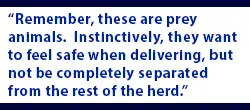
Checklist: Maternity pen and fresh does
 By Sarah Adamson
By Sarah Adamson
Kidding season is right around the corner – are you ready? Having a maternity pen and doe checklist can help ensure a smooth delivery for the animals and make sure staff are prepared. Listed below are just a few items and areas to include on your checklist.
Pen cleanliness
Cleanliness is key. Bacteria present in the maternity pen are the first bacteria to touch the newborn’s navel, and potentially get into its mouth and gastrointestinal tract. Continuously bedding over dirty bedding does not guarantee a clean maternity area. Make a point to completely clean out the area on a regular basis.
Bedding
Adequate deep bedding is important for animal comfort and for the “soon-to-be-mom” to make a clean nest for delivery. Does tend to kid in the same area of the barn, which allows you to diligently clean that specific area and keep it well-bedded.
 Quiet
Quiet
It is important to create a quiet area for the doe to give birth for her comfort and health. Section off and cover a corner of the maternity pen where the doe can enter on her own and proceed with labor. Remember, these are prey animals. Instinctively, they want to feel safe when delivering, but not be completely separated from the rest of the herd.
Minimize stress on does
If you are moving animals into a maternity pen, try to avoid moving them too close to kidding to keep stress to a minimum. It can help to move at least three animals into the maternity pen at a time. Never move one animal by herself, and, if possible, try to avoid moving yearlings and first fresheners into a maternity pen full of older does.
Post-kidding care
Although does will not require assistance during kidding in most cases, it is best to be prepared by organizing a birthing kit that includes OB soap, a clean bucket, lubricant, disposable OB gloves, OB equipment, towels, and a basic understanding of proper kid anatomical orientation during the birthing process. Be patient and gentle when assisting the kidding process and do not hesitate to call a vet if you feel uncomfortable providing assistance.
Once the doe kids, rehydrate the doe with warm water and added electrolytes as soon as possible, milk out colostrum, and make sure she cleans.
If it was a tough kidding, work with your veterinarian to determine the proper course of treatment for post-kidding health events.
This isn’t an all-encompassing checklist. Take the time to sit down and think about the goals of your maternity program. Create a checklist that will meet those needs and communicate it with your staff to ensure consistent treatment.
In my next post, we will talk about the items you should include on a newborn kid checklist.
About the author: Sarah Adamson grew up on her family’s commercial dairy goat farm in southern Wisconsin. She attended the University of Wisconsin-Platteville and received her bachelor’s degree in animal science, with an emphasis on dairy science. Adamson spent time as a manager on an 8,000-head dairy goat farm before joining Vita Plus in 2018. As the Vita Plus dairy goat specialist, Adamson is responsible for product development for the entire dairy goat program as well as technical support for field staff in the Vita Plus market area.
| Category: |
Animal health Dairy Goat Performance Maternity |

